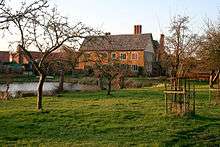Fish pond

A fish pond, or fishpond, is a controlled pond, artificial lake, or reservoir that is stocked with fish and is used in aquaculture for fish farming, or is used for recreational fishing or for ornamental purposes. In the medieval European era it was typical for monasteries and castles (small, partly self-sufficient communities) to have a fish pond.
History
During the winter, supplying fresh food for a castle garrison was a constant struggle. Although meat would be available from deer parks, this couldn't supply the needs of the whole household. A fish pond provided an elegant solution. As long as there was a natural flow of water into the pond, fish required no feeding and were available all year round. There would usually be a series of ponds, with fish being moved between them as they grew.
Aquaculture
Fish ponds are used today in aquaculture. They are common in:
- Canada
- Europe, especially in the Czech Republic (Rožmberk Pond, Velké Dářko, Lake Mácha), where common carp may be kept.
- The Philippines where milkfish, tilapia, crabs, lobsters, tiger shrimp, snails and others may be kept.
- East Asia, especially in Japan with koi, trout, and white crucian carp.
Fish ponds are also being promoted in developing countries. They provide a source of food and income from the sale of fish for small farmers and can also supply irrigation needs and water for livestock.[1]
Gallery
 Classic fishing pond used by the Clay Cross Angling Club
Classic fishing pond used by the Clay Cross Angling Club Fishing pond on Grainthorpe Fen
Fishing pond on Grainthorpe Fen Coarse fishing pond in England
Coarse fishing pond in England Medieval fish pond
Medieval fish pond Historic fish pond
Historic fish pond Fishing platform, designed for wheelchair users, at the edge of a fish pond.
Fishing platform, designed for wheelchair users, at the edge of a fish pond.
See also
| Wikimedia Commons has media related to Fish ponds. |
Notes
- ↑ FAO, Farm ponds for water, fish and livelihoods FAO, Rome, 2009
References
- Aston M (1998) Medieval fish, fisheries and fishponds in England Volumes 1-2. B.A.R. ISBN 978-0-86054-509-5.
- Chattopadhyay GN (1998) Chemical Analysis of Fish Pond Soil and Water Daya Publishing House. ISBN 978-81-7035-177-1.
- Compton LV (1943) Techniques of fishpond management U.S. Dept. of Agriculture.
- Delincé G (1992) The ecology of the fish pond ecosystem Kluwer Academic Publishers. ISBN 978-0-7923-1628-2.
- Farber JM (1997) Ancient Hawaiian fishponds: can restoration succeed on Molokaʻi? Neptune House Publications. ISBN 978-0-9659782-0-0.
- Gopalakrishnan V and Coche AG (1994) Handbook on small-scale freshwater fish farming Training Series No. 24, FAO, Rome. ISBN 92-5-103163-0.
- Hoare J (1870) A treatise on fishponds, addressed to the nobility and gentry of Sussex Wyman & sons, original from Harvard University.
- IUCN (1997) Fishing for a living: the ecology and economics of fishponds in Central Europe ISBN 978-2-8317-0386-2.
- FAO (1996) Simple methods for aquaculture: Management for freshwater fish culture: Ponds and water practices Training Series No. 21/1, Rome.
- FAO (1995) Simple methods for aquaculture: Pond Construction for Freshwater Fish Culture: Building Earthen Ponds FAO Training Series No. 20/1, Rome.
- FAO (1992) Simple methods for aquaculture: Pond Construction for Freshwater Fish Culture: Pond-Farm Structures and Layouts FAO Training Series No. 20/2, Rome.
- FAO (1989) Simple methods for aquaculture: Topography: Making topographical surveys for freshwater fish culture Training Series No. 16/2, Rome.
- FAO (1981) Simple methods for aquaculture. Water for freshwater fish culture Training Series No.4, Rome.



